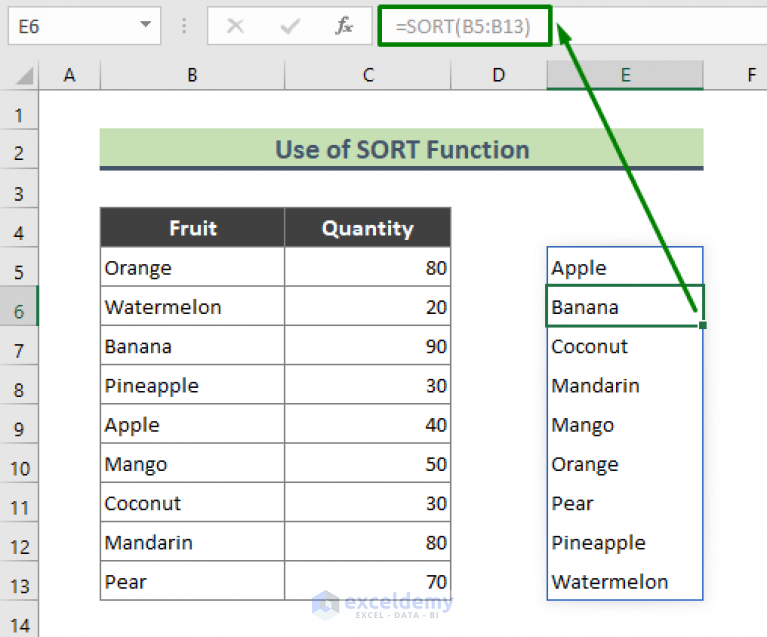Excel's Easy Drop-Down Sort Technique

Welcome to an in-depth exploration of a powerful yet straightforward feature in Excel: the drop-down sort technique. This article aims to uncover the simplicity and effectiveness of this tool, providing a comprehensive guide to enhance your data management skills. Get ready to discover how a few clicks can revolutionize your Excel experience and elevate your data organization game.
Mastering Excel’s Drop-Down Sort Technique

Excel, the ubiquitous spreadsheet software, is a powerhouse for data management and analysis. Among its vast array of features, the drop-down sort technique stands out for its ease of use and immense practicality. This tool allows users to create dynamic, customizable lists that can be easily sorted and filtered, transforming raw data into organized information with just a few clicks.
Understanding the Drop-Down Sort
The drop-down sort technique is a feature in Excel that enables users to create a list of items within a cell, providing a user-friendly interface for data entry and selection. This list can then be sorted and filtered, making it an invaluable tool for data organization and analysis. The process involves creating a data validation list, which then acts as a drop-down menu within a cell, offering a range of options for users to choose from.
For instance, imagine you're working on a project that involves categorizing a large dataset based on regions. Instead of manually typing each region or scrolling through a long list, the drop-down sort technique allows you to create a list of regions within a cell. Users can then simply select the desired region from the drop-down menu, making data entry faster and more accurate.
| Region | Data Validation List |
|---|---|
| North | North, South, East, West |
| South | North, South, East, West |
| East | North, South, East, West |
| West | North, South, East, West |

Step-by-Step Guide to Implementing the Drop-Down Sort
-
Select the Cell(s): Begin by selecting the cell or range of cells where you want the drop-down list to appear. This is the cell where users will make their selections.
-
Create the Data Validation List: Navigate to the Data tab in Excel’s ribbon and click on Data Validation. In the Data Validation dialog box, select List from the Allow drop-down menu. Here, you’ll input the items for your drop-down list, separated by commas. For example, if you’re creating a list of colors, you might enter Red, Blue, Green, Yellow.
-
Apply the Validation: Once you’ve entered your list, click OK to apply the data validation. Now, when you click on the cell, a drop-down arrow will appear, allowing users to select from the predefined list.
-
Sort and Filter: With your drop-down list in place, you can now easily sort and filter your data. Simply use Excel’s standard sorting and filtering tools to organize your data based on the selections made from the drop-down list.
Advantages of the Drop-Down Sort Technique
-
Enhanced Data Entry: The drop-down sort technique simplifies data entry by providing a clear, user-friendly interface. This reduces the risk of errors and ensures data consistency, especially when working with multiple users.
-
Improved Data Organization: By creating a structured list, you can easily sort and filter your data, making it more manageable and allowing for quick data analysis.
-
Dynamic and Customizable: Excel’s drop-down sort is highly flexible. You can easily update and customize your lists as your data needs evolve, ensuring your spreadsheets remain relevant and useful.
Real-World Applications
The drop-down sort technique finds applications in various scenarios, from simple spreadsheets to complex data management systems. Here are a few examples:
-
Product Catalogs: For businesses managing product inventories, drop-down lists can be used to categorize products based on attributes like color, size, or brand, making it easier to track and manage inventory.
-
Surveys and Questionnaires: When creating surveys or questionnaires in Excel, drop-down lists can provide structured options for respondents, ensuring consistent data collection.
-
Project Management: In project management spreadsheets, drop-down lists can be used to assign tasks to team members, track project phases, or categorize tasks by priority or deadline.
Tips and Best Practices
-
Keep Lists Concise: While drop-down lists can be long, it’s best to keep them concise and relevant to avoid overwhelming users. Consider breaking down long lists into multiple drop-downs or using a hierarchical structure.
-
Use Descriptive Labels: Ensure that the labels in your drop-down lists are clear and descriptive. This helps users understand the options and makes your spreadsheet more user-friendly.
-
Regularly Update Lists: As your data changes, remember to update your drop-down lists accordingly. This ensures that your spreadsheet remains accurate and useful.
Conclusion
Excel’s drop-down sort technique is a powerful yet often underutilized feature. By creating dynamic, customizable lists, users can streamline data entry, enhance data organization, and simplify data analysis. With its ease of use and flexibility, this technique is a valuable asset for anyone working with data in Excel, from beginners to advanced users.
How can I create a multi-level drop-down list in Excel?
+To create a multi-level drop-down list, you can use a hierarchical structure. Start by creating a primary drop-down list, and then within each option, create a secondary drop-down list. This allows for more complex data categorization and selection.
Can I use the drop-down sort technique with large datasets?
+Absolutely! The drop-down sort technique is particularly useful for large datasets as it simplifies data entry and organization. It can handle extensive lists and make data management more efficient.
Is it possible to automatically update drop-down lists based on changes in my spreadsheet?
+Yes, you can use Excel’s dynamic data validation feature to automatically update drop-down lists based on changes in your spreadsheet. This ensures that your drop-down lists remain accurate and up-to-date.



